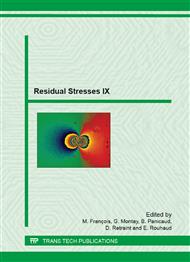p.52
p.58
p.64
p.70
p.76
p.82
p.88
p.94
p.100
Evaluation of Welding Residual Stresses Using Diffraction Spot Trace Method
Abstract:
A diffraction spot trace method (DSTM) is very useful to measure internal stresses of materials with coarse grains. In this study, validity of the DSTM was examined using high energy synchrotron X-ray of 70 keV. The specimen was a welded plate of austenitic stainless steel (SUS316L). The thickness of the specimen was 9 mm. The improved spiral slit system was used, and PILATUS was used as an area detector. It was difficult to detect the high energy X-rays due to the reduction of counting efficiency of the PILATUS. However, the residual stress map of the welding specimen was obtained by long exposure time. The residual stresses of the welding specimen were simulated by a finite element method (FEM). The outline of the residual stress measured by the DSTM coincided with that by the FEM.
Info:
Periodical:
Pages:
76-81
Citation:
Online since:
August 2014
Authors:
Permissions:
Share:
Citation:


